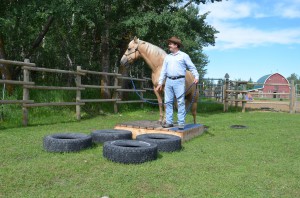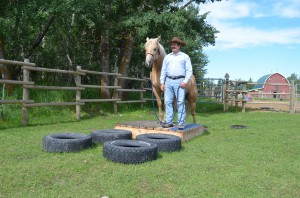An essential component of leadership is that our followers emulate us. That applies in many facets of life: your children copy what you do. They are little mirrors of you. Sometimes they key in on certain words you say and repeat them in inappropriate places! On a personal note, I can be a practical joker…oddly enough I’ve been told that Chip – my 6 year old gelding that I’ve raised and trained is just like me. Words like ‘brat’ or ‘mischievous’ or ‘playful’ are commonly heard. He is undoubtedly a mirror of my own personality. Here’s a little clip of us playing yesterday.
But the concept of mirrors extends way beyond that. And we can capitalize on it.

Horses don’t have an extensive verbal vocabulary to communicate with each other about how they are feeling. But that doesn’t mean they are not able to the opposite is in fact, true. As a prey animal, the horse species has had to hone many senses in order to survive. One essential sense that is very keen on a horse is that of empathy. The dictionary definition of that word is, The psychological identification with the feelings, thoughts or attitudes of others.
Consider it. One horse senses danger and the entire herd reacts simultaneously. Or think about riding in an arena where the mood of the horses has been very calm…or the opposite. A horse can feel -and mirror – what other horses are feeling. It’s simply an intrinsic part of their communication.
That said, they can most certainly feel what you are feeling. If you are tense, angry, nervous, happy, proud, excited or distracted, you can bet your horse knows that. And if you are established as a leader, then your horse is able to follow your emotional state.

Consider the ramifications of that: you can take a nervous horse to a peaceful state largely by just changing how you feel; by presenting yourself as a calm leader. You can also make a mental mess of a horse by being a mental mess yourself, for example, getting frustrated because your horse is having difficulty getting in the trailer.
A real-life indication of the leadership status you have with your horse can be found when the chips are down. Lets say that something scary happens on a trail ride. Does your horse follow you in your confidence, or other horses in their fear?

Not only do horses follow us emotionally, they follow us physically. A rider that slouches in the saddle or leans in a turn will likely be riding a horse that hangs his head low or falls into a turn. To think about how that feels to a horse, think about piggy-backing a four year old kid that suddenly leans WAY over to the front or side. You’ll be doing a balancing act to prevent yourself from falling. It’s no different with the horse: if you shift all over the place in the saddle, the horse has to continually work to keep you balanced up there. Simply sitting tall and straight, looking up and focusing on your path will produce a horse that is able to elevate and focus on a direction. He will be able to follow you much easier, mirroring your proper posture.

Lets consider someone that has this issue: “Why is my horse so fussy ?” By ‘fussy’ they are referring to the horse flipping his head about. On observation we see this is happening when the rider has pressure on the reins or lead rope. The horse is frustrated because nothing – in the language of the horse – is being communicated to them to let them know what the rider is asking. The horse then has to guess – but any wrong guess is met with a rein. How do we stop the fussiness? Well, we start by putting some slack in the reins. The horse won’t fuss if he has nothing to fuss against!
Calm your hands to produce a calm horse. Horses will get fussy when the reins are used to constantly tell the horse no.
The main point here is that the rein or lead rope is NOT a tool to tell your horse no. If the horse is not following you, there are positive and encouraging actions you can take to build that leadership relationship with him.
I spent today teaching a group of kids – some of them new to riding – how to steer their horses on obstacles simply with proper posture and focus. An observer noted, “I’ve spent 20 years trying to figure out how to do that!” It’s not hard. It does however require the rider to let go of the concept of the reins as dirtbike handlebars and communicate properly with the horse.
We work towards having our horses follow our direction and intention aided by minute physical cues. This is built in the groundwork and translates directly to the saddle. Here are a couple of pointers you can practice right away:
- Look where you’re going, not at the ground, the back of your horse’s head or your hands. Simply by concentrating on your path you are giving your horse something to follow.
- Use your reins with the lightest of touch. You’ll be able to ask the horse for small releases and determine through the feel of the reins if he’s still thinking of you OR thinking of something else.
The horse should be able to follow your lead and initiate or perform a maneuver without you picking up a rein at all – a mirror of your intent. If that isn’t the case, a combination of things is probably happening:
- Your horse is above you in the herd order or does not view you as a leader and thus does not have an inclination to follow you (or is testing this); and/or
- Your presentation lacks focus or clarity. Either you are not asking or your horse doesn’t know what you’re asking and thus will follow his thought instead of yours; and/or
- Your horse is unable to follow you or move properly because he’s in a state of brace induced by fear, improper rein use or negative expectations based on his previous experience (like his face being yanked on).
It’s fairly common to work through these things with the students in our clinics. We work through exercises that build, clarify and maintain your status as the herd leader while at the same time showing your horse how to release and relax so that he can use his body like any athlete should. We build your horse’s trust in you and show you how to communicate your thought and energy to him so he has something concise to follow like the lead horse does in the herd.
Generally we clean up some things in short order, taking your riding and connection to a whole new level and producing a horse that is a willing, accepting and calm partner that will try for you. We had a student in our last clinic say, “I’ve been riding my whole life and I just learned how to lead a horse!” Another comment was, “This is all common sense, but we just never think of it.” That’s very true. There is no mystery, there is no secret method or fancy tool required. Horsemanship is in part a product of leadership and communication.
Consider your horse as a mirror of you, both physically and emotionally. Be the horse you want your horse to be. Being a leader is not simply a groundwork exercise, you lead a horse in the saddle as well by giving them something to follow: your energy, intent, focus and emotional state. You’d be surprised at how simple it is, and how profound the results are – particularly when your horse realizes you’re finally speaking a language he understands.
Scott Phillips
June 2016
